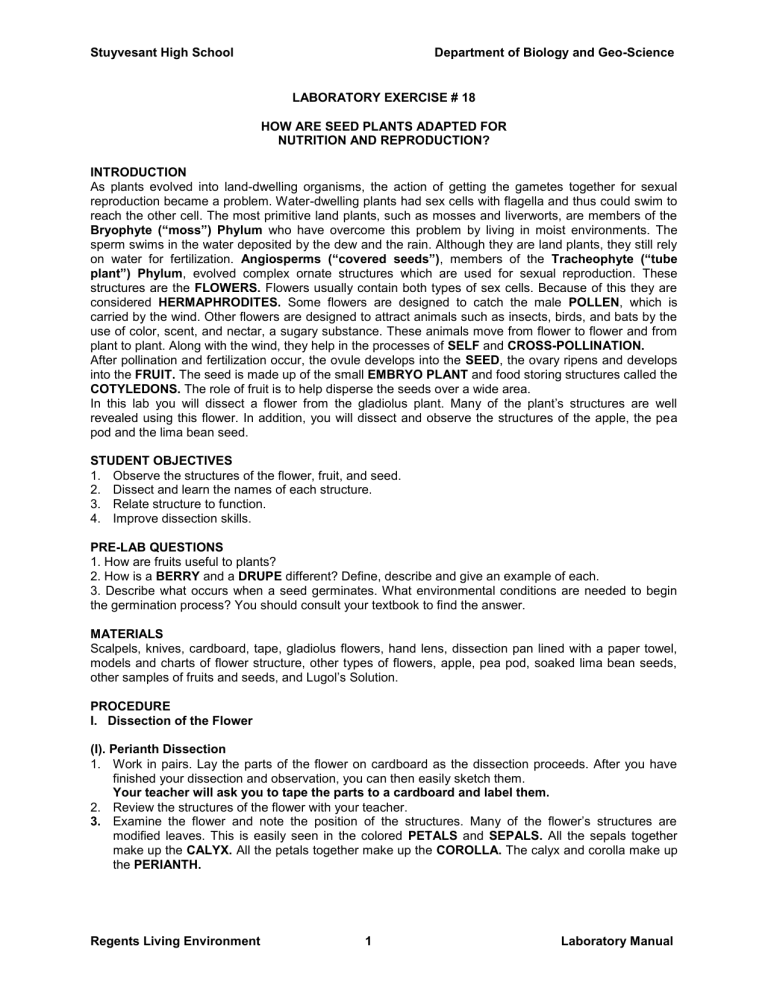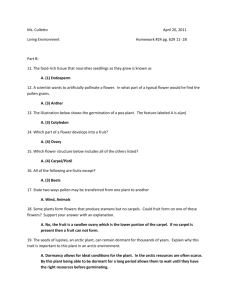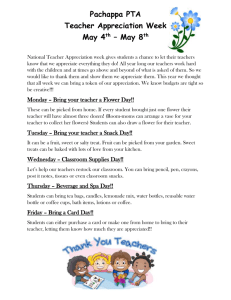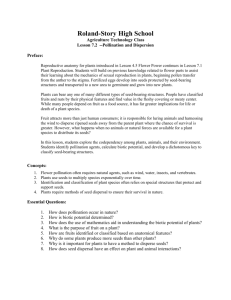LAB 18 - Stuyvesant High School

Stuyvesant High School Department of Biology and Geo-Science
LABORATORY EXERCISE # 18
HOW ARE SEED PLANTS ADAPTED FOR
NUTRITION AND REPRODUCTION?
INTRODUCTION
As plants evolved into land-dwelling organisms, the action of getting the gametes together for sexual reproduction became a problem. Water-dwelling plants had sex cells with flagella and thus could swim to reach the other cell. The most primitive land plants, such as mosses and liverworts, are members of the
Bryophyte (“moss”) Phylum who have overcome this problem by living in moist environments. The sperm swims in the water deposited by the dew and the rain. Although they are land plants, they still rely on water for fertilization. Angiosperms (“covered seeds”) , members of the Tracheophyte (“tube plant”) Phylum , evolved complex ornate structures which are used for sexual reproduction. These structures are the FLOWERS.
Flowers usually contain both types of sex cells. Because of this they are considered HERMAPHRODITES.
Some flowers are designed to catch the male POLLEN , which is carried by the wind. Other flowers are designed to attract animals such as insects, birds, and bats by the use of color, scent, and nectar, a sugary substance. These animals move from flower to flower and from plant to plant. Along with the wind, they help in the processes of SELF and CROSS-POLLINATION.
After pollination and fertilization occur, the ovule develops into the SEED , the ovary ripens and develops into the FRUIT. The seed is made up of the small EMBRYO PLANT and food storing structures called the
COTYLEDONS.
The role of fruit is to help disperse the seeds over a wide area.
In this lab you will dissect a flower from the gladiolus plant. Many of the plant’s structures are well revealed using this flower. In addition, you will dissect and observe the structures of the apple, the pea pod and the lima bean seed.
STUDENT OBJECTIVES
1. Observe the structures of the flower, fruit, and seed.
2. Dissect and learn the names of each structure.
3. Relate structure to function.
4. Improve dissection skills.
PRE-LAB QUESTIONS
1. How are fruits useful to plants?
2. How is a BERRY and a DRUPE different? Define, describe and give an example of each.
3. Describe what occurs when a seed germinates. What environmental conditions are needed to begin the germination process? You should consult your textbook to find the answer.
MATERIALS
Scalpels, knives, cardboard, tape, gladiolus flowers, hand lens, dissection pan lined with a paper towel, models and charts of flower structure, other types of flowers, apple, pea pod, soaked lima bean seeds, other samples of frui ts and seeds, and Lugol’s Solution.
PROCEDURE
I. Dissection of the Flower
(I). Perianth Dissection
1. Work in pairs. Lay the parts of the flower on cardboard as the dissection proceeds. After you have finished your dissection and observation, you can then easily sketch them.
Your teacher will ask you to tape the parts to a cardboard and label them.
2. Review the structures of the flower with your teacher.
3. Examine the flower and note the position of the structures. Many of the flower’s structures are modified leaves. This is easily seen in the colored PETALS and SEPALS. All the sepals together make up the CALYX. All the petals together make up the COROLLA.
The calyx and corolla make up the PERIANTH.
Regents Living Environment 1 Laboratory Manual
Stuyvesant High School Department of Biology and Geo-Science
4. Count the number of each type of organ. You should come up with either three or a multiple of three. This is characteristic of
MONOCOT flowers. Multiples of four or five are characteristic of
DICOT flowers.
5. Note the presence of two green “leaves” at the base of the flower.
These are not part of the flower itself, but of the stem. These
“leaves” are called the BRACTS.
6. Carefully remove the bracts and lay them on the cardboard. Note the presence of the bulge below the bottom of the colored leaves.
This is called the OVARY , the lower part of the female organ of the flower. The female part is called the PISTIL or if it is made up of many chambers, the CARPEL. Using your scalpel, carefully make a cut below the ovary and slice the flower off the stem.
7. Observe the colored leaves of the flower. Note that three are
“outside” and three are “inside”. The outside ones are called the
SEPALS.
The inside three are the real
PETALS. In this type of flower, they have fused. We call the individual members of the gladiolus flower perianth TEPALS. In most other plants, the sepals and petals are different colors or look different from each other. Make a slice between two tepals. Peel off the perianth in one piece. The stamens may come off with the tepals. The stamens and the tepals are modified leaves fused to each other.
(II). Dissection of Reproductive Structures
1. The remaining structures of the flower are the sex organs themselves: The male STAMENS and the single female PISTIL.
Locate the 3 stamens. These structures form a ring around the pistil. Gently pull off the stamens. Observe the structure on the top. This is called the ANTHER. Use your scalpel to make a horizontal cut through the anther. Note that it consists of two parts. These are called the
POLLEN SACS. If the pollen is ripe, the anther opens by itself. The powdery pollen is now free to stick to the leg of an insect or to be carried by wind currents. The stalk is called the FILAMENT.
Observe the pollen with the hand lens. Lay the stamen parts on the cardboard.
2. Observe the pistil. It consists of the STIGMA , the
STYLE , and the OVARY. Sprinkle some pollen on the stigma and observe what happens. After fertilization, the enlarged ovary becomes the
FRUIT. When a plant contains both sex organs, it is considered MONOECIOUS (“one house”). All the parts other than the stamens and pistil are considered ACCESSORY organs. These accessory organs help pollination to occur. Some flowers consist only of the sex organs or may only contain some, but not all, of the accessory organs. Some flowers may only contain one type of the sex organ. A plant with flowers containing only pistils or only stamens is called a FEMALE plant or MALE plant, respectively. This type of plant is considered DIOECIOUS (“two houses”).
The English Holly, the one associated with Christmas, is a dioecious plant species. If you do not have both the male and female bushes, the female will not be able to produce the red fruit.
3. Use the scalpel to make a horizontal cut through the center of the ovary. The seed-like structures are called the OVULES. They contain the unripe female sex cells. When fertilization occurs, the ovules will become the seeds. Observe that the ovary is divided into sections. Each section is called a
Regents Living Environment 2 Laboratory Manual
Stuyvesant High School Department of Biology and Geo-Science
CARPEL. The space in the carpel is called a LOCULE. Count the number of locules (In oranges, we call the carpels “sections”). Lay the pistil parts on the cardboard.
II. Dissection of Fruit
When fertilization occurs, the ovule, which contains the zygote (fertilized egg cell), develops into a seed and the ovary receives signals which tell it to undergo growth and differentiation. The matured ovary develops into the seed-containing fruit. Sometimes other accessory organs become part of the fruit structure. We think of fruits as being juicy, like the apple, which you will dissect today. But fruits can be dry like the gr ains, walnuts, and the spiny sweet gum fruit (“sticky balls”). Botanically, anything that contains a seed is a fruit. Burrs, eggplants, tomatoes, maple tree “polly noses,” and dandelion fluff are all fruits. (Consult your textbook for the different types of fruits.) The only job of a fruit is to help disperse the seeds. By means of the wind, water, the digestive tracts, fur, and the sloppy eating habits of animals, plants are able to spread their seeds into areas which might have less competition for water, light and nutrients.
(I). The Apple – A Pome
1. Work in pairs. Pick up the apple and observe it. Note the “leafy” structures on the bottom. These are the remains of the sepals. The stem of the apple is where the apple flower attached to the branch.
The bottom of the apple is really the top of the flower! Refer to the chart of the apple flower and fruit and study the diagrams. Note that the ovary is imbedded in the accessory organ called the
RECEPTACLE . The receptacle gives support to the flower. In the apple, the part we eat, the fleshy
PERICARP (“ around the carpel ”) consists of an enlarged receptacle. This type of fleshy fruit is called a POME . Another example is the pear.
2. Cut the apple in half horizontally. The thin, tough outer epidermis is covered by a waxy cuticle.
Chloroplasts in the young green apple change into pigment containing CHROMAPLASTS as the fruit ripens. The chief color pigments are the ANTHOCYANINS and CAROTENOIDS .
3. Observe the thick pericarp. It consists of storage cells which make up tissue called PARENCHYMA .
A mealy apple has many air spaces in the parenchyma. The regularly distributed “dots” are the remains of the vascular tissue for the petals.
4. Inside the ring of the “dots” is the CORE . The core is actually the MATURED OVARY . Inside the ovary observe the five fused compartments called CARPELS . The space containing the SEEDS is called the LOCULE . Count the number of carpels.
1. calyx depression or basin
2. calyx tube
3. core flesh
4. carpel and seeds
5. inner cortex
6. outer cortex
7. cuticle and skin
8. stem cavity or basin
1. cuticle and skin
2. subepidermal tissues with
network of capillary
3. outer cortex
4. inner cortex
5. radial vascular
6. coreline vascular
7. carpel and seeds
8. coreline
9. coreflesh
Regents Living Environment 3 Laboratory Manual
Stuyvesant High School Department of Biology and Geo-Science
(II). The Tomato – A Berry
Pick up the tomato and observe it. A tomato is a fleshy fruit called a BERRY . A berry is a fruit in which the seeds are distributed throughout the matured ovary flesh. Watermelons, eggplants, and kiwi fruit are also examples of berries. Botanically, raspberries and strawberries are NOT considered berries! Look for these fruits in your text book to find out more about them.
1. Cut the tomato in half horizontally. Note the presence of several carpels separated by partitions of fleshy tissue. Observe the materials within each carpel.
2. Much of the locule (the space within carpel) consists of opaque, pale tissue. This is the
PLACENTA which is located nearest the center of the fruit. It is supporting tissue for the seeds. As the tomato ripens, CELLULASE is secreted into the space and the placenta becomes liquefied and translucent.
3. Note that seeds are attached to the placenta by means of a tiny thread called the FUNICULUS . This is difficult to see in the apple.
4. The pericarp (outer flesh) of the tomato has a tough coat. Unlike the apple, this fruit’s flesh is made up of the ovary and not the accessory receptacle.
5. The ripening of a tomato involves the absorption of light by PHYTOCHROME (a type of plant pigment), ETHYLENE GAS PRODUCTION , and other biochemical events. Chromaplasts develop which contain CAROTENOIDS , the pigments which give tomatoes their characteristic red-orange color.
(III). Pea Pod - A Dry Fruit
1. Observe the pod, the fruit of the pea plant. It is dry, and not a “juicy” fruit. Note the two “seams” on the side. This fruit is called a
DEHISCENT fruit. This means that when it dries, it splits open along one or more seams because of stress in the walls of the pod. The seeds are flung out. It is a very effective method of dispersal. Unlike fleshy fruits, which attract hungry animals to help disperse them, dry fruits must use other methods. Some dry fruits rely on wind or cling to the fur and feathers of animals. (Pomes and berries are
INDEHISCENT. They do not split when they are ripe.)
2. The wall of the pod, the pericarp, is composed of a matured ovary and has a single carpel. Since the pericarp is very thin, it is hard to distinguish its layers. The innermost layer defines the carpel. Observe the presence of sepals at the stem end.
3. Use your nail to carefully split the pod along one side. Do not separate the sides if possible. Leave them attached at the stem end. The seeds (“peas”) are located in the large locule. Count the number of peas.
4. Note the presence of the FUNICULUS, which attaches the pea to the area of the pericarp called the
PLACENTA. The placenta of the pea, unlike that of the tomato, is very small. It appears as a thin strip of tissue that runs the length of the pericarp.
III. Seeds (lima bean)
1. Carefully examine the soaked lima bean seed. Study the diagram of the seed. The tough, outer coat is called the TESTA.
On the inner curve of the bean is a white scar called the HILUM.
This is where the bean attached to the funiculus in the pod. Note the presence of a small hole called the
MICROPYLE , This is where the sperm nucleus entered the OVULE.
Regents Living Environment 4 Laboratory Manual
Stuyvesant High School Department of Biology and Geo-Science
2. Carefully remove the testa from the outside edge. Note that it seems to be attached at one end of the seed.
3. Gently split the two sides, the COTYLEDONS , apart. Look for the EMBRYO PLANT located at one side of a cotyledon. Use a hand lens to observe the parts of the embryo. The PLUMULE is the leaflike structure. The plumule is the first set of real leaves. The small root-like structure is the
HYPOCOTYL.
This will develop into the first root.
4. The cotyledons contain stored food and enzymes. Scratch one cotyledon with your finger and place two drops of Lugol’s Solution on the cotyledon. Determine if starch is present.
5. Repeat this section using a pea from your pod and a corn seed if available. Note the similarities and differences.
6. Study the chart of seed germination and seedling development on the chart in the lab room or in your textbook.
Regents Living Environment 5 Laboratory Manual









